More about: Things to Do in Krakow in 1 Day
Despite only having one day in Kraków, a good itinerary will allow you to see the city's must-see sights. The small size of Stare Miasto (the World Heritage-listed Old Town) and the short walking distances will allow you to visit at least the Market Square, Wawel Castle and part of the Jewish Quarter.
Look for the Wawel Dragon on the banks of the Vistula River.
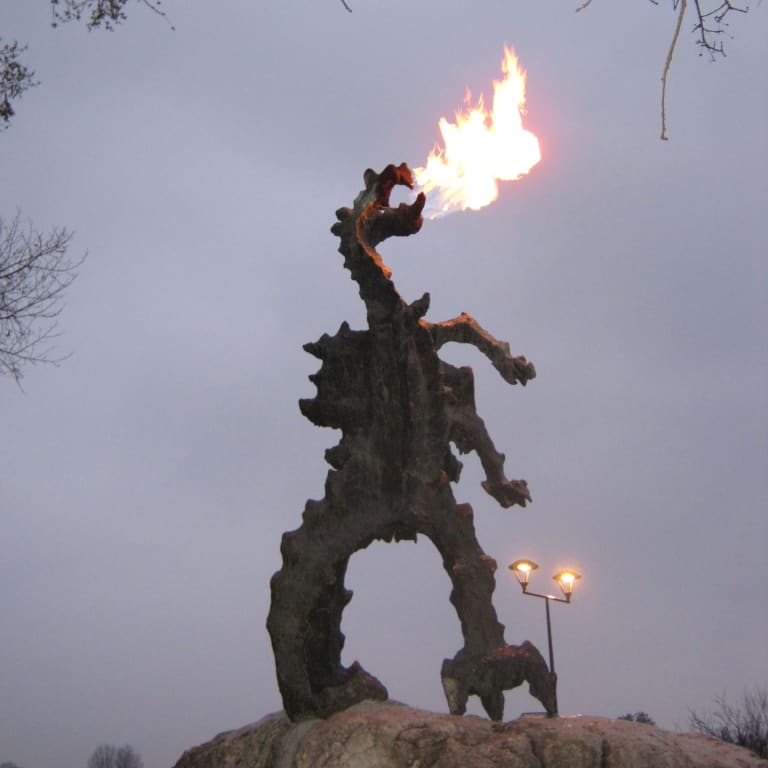
To begin your tour of Kraków, it's important to be sure to get up early to make up for the lack of time. The first place to go is to the banks of the Vistula River, more specifically to the iron statue of a dragon located under Wawel Hill.
This dragon is one of the main symbols of the city. The legend, which you can read in more detail at this link, tells that many centuries ago, such an animal inhabited a cave on the hill and terrorised the inhabitants of the area. The fact that the statue spits fire out of its mouth every few minutes certainly puts it at the top of the list of things to do in Krakow with children, as they are sure to be fascinated.
On the other hand, the so-called Dragon Cave, located next to the statue, can be visited during the summer months. However, on this occasion we will have to pass it up in order to continue with the itinerary.
Guided or self-guided tour?
There are several guided tours in Kraków that will take you to approximately the points of interest I have indicated. For example, a tour of Krakow by segway. Whether you go on a self-guided or organised tour has pros and cons, so it's up to you to decide what to do.
- The main advantage of a tour, especially when you are short on time, is that you will get to the sights without having to stop and get your bearings. In addition, the guides will always provide you with interesting information.
- Krakow is a very easy city to explore on your own, as its size means that you can get almost everywhere on foot. However, even if you prefer this option, it is worth hiring a guide for some of the tours.
Climb Wawel Castle and soak up some history
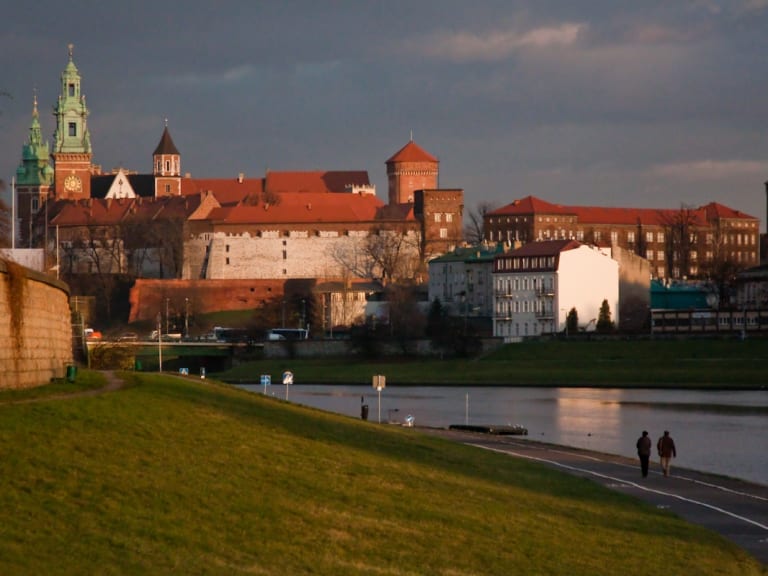
From the base of the hill, a short climb up to one of Kraków's must-see sights: Wawe Castle. This castle, named after the hill on which it was built, is one of the symbols of Polish national identity, as well as being one of its cultural centres. It was also the official residence of the country's kings for several centuries.
The complex is quite large, with a large central courtyard surrounded by several buildings, all with interesting interiors that are worth a visit with time to spare. If you book a guided tour of Wawel Castle you will see:
- The John Paul II Cathedral Museum: inaugurated by Karol Wojtyła, the Polish-born pope in 1978, it has an exhibition of religious artefacts.
- The entrance to the Dragon's Cave: from the castle you can access the cave where the legendary dragon lived.
- The Royal Palace: it was the first seat of the Polish monarchy. Later, the building was abandoned until it was rebuilt again.
- Other attractions include the Sandomierska Tower, the armoury and the remains known as the "Lost Wawel".
My advice, given the lack of time, is to dedicate the visit to see the exterior of the castle and the inner arcaded courtyard. The Palace and the royal flats take several hours, so it might be better to leave them for another time.
Practical information
- Price: Admission to the courtyard is free, while each of the attractions has a different price.
- Opening hours: Opening hours are 9.30am-5pm.
Enter the Wawel Cathedral, a symbol of Catholic Poland
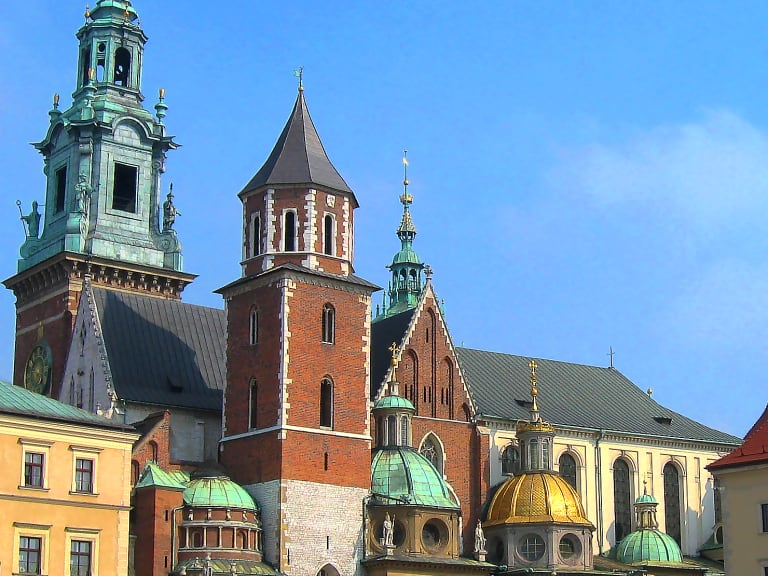
If you book a tour of the Old Town, you will find one of the most important cathedrals in the country inside the hilltop enclosure. This temple, with more than 1000 years of history, was the place where some of the Polish kings were crowned and also buried. Together with the palace, the Gothic-style Wawel Cathedral made the Wawel Hill the centre of religious and political power in the country for many centuries.
Inside you can see 18 funerary chapels, among which the one of Sigismund I stands out, considered to be the best example of the Renaissance in Poland. Also of interest is the mausoleum of St. Stanislaus, the patron saint of the country. Finally, it is worth climbing the Sigismund Tower and contemplating the 12-ton bell that stands there.
Practical information
- Price: Admission to the Cathedral is free, but the Sigismund Chapel costs about 15 zlotys (just over 3 euros). Students and pensioners pay half price.
- Opening hours: Monday to Saturday, the Cathedral is open from 9am to 5pm (except from September to March, when it closes one hour earlier). On Sundays it opens at 12:30 p.m..
Stroll along Grodzka Street
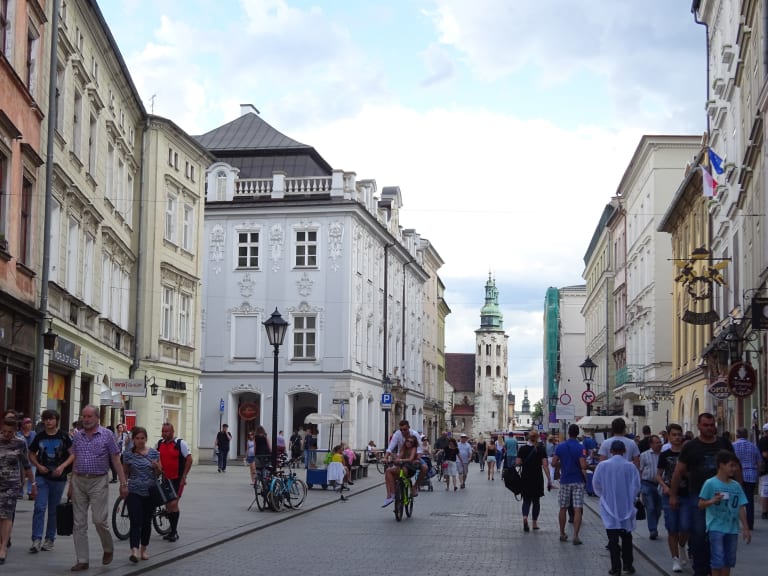
If you book a tour of the Old Town, after leaving the Cathedral, you should go down the hill and look for Grodzka Street, one of the liveliest streets in this World Heritage Site. This street, today eminently commercial, was once part of the so-called Royal Way, a route that crossed the entire walled enclosure from the castle to St. Florian's Gate.
During this walk you can take the opportunity to browse the craft shops, but without losing sight of the beautiful pastel-painted façades of the 16th and 17th century buildings. If you prefer, you can choose the street parallel to Grodzka, the Kanonicza, where you can see Renaissance houses and some old churches.
No matter which one you walk along, during the tour you should stop at the Church of St. Peter and St. Paul to see the statues of the 12 apostles. The Church of St. Andrew is also worth a visit for its baroque style. Both are among the most important churches in Krakow.
Visit the Market Square, the heart of the city.
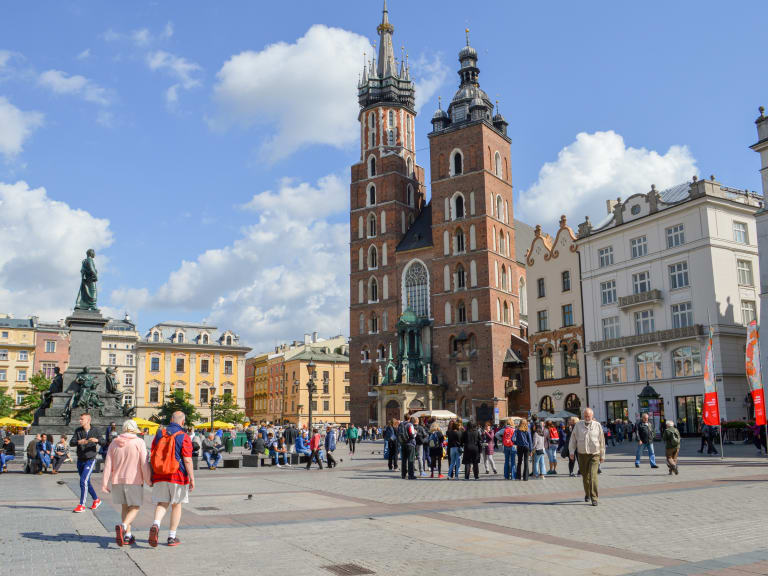
At the end of Grodzka Street is the extraordinary Market Square with all its monuments and activities, one of the places to see in Krakow
. It is, without a doubt, the heart of the historical centre and the city's landmark. Surrounded by Renaissance-style buildings, it is one of the most beautiful medieval squares on the continent.
If you go to Kraków at Christmas, you cannot miss the fabulous flea market that is set up here and which you can visit while you listen to the Christmas choirs that perform on some of the stages set up for the occasion.
Discover the most unique places in the Market Square

The Market Square needs you to set aside a couple of hours to discover it in depth because it has some very outstanding places that you can't miss. This is the case of the Basilica of Santa María, where you can see the largest wooden altarpiece in Europe, measuring 12 metres in length. You can also climb one of its two Gothic towers to see the views.
A visit to the Lonja de Paños, built in 1257 and today occupied by several souvenir and craft shops, is a must. The beauty of this palace makes it one of the most photographed in Kraków. In its time, it was a place dedicated to trade, to the extent that some historians consider it to be the first commercial centre in history. You can go up to the first floor of the building where the National Museum of Krakow is located, or go underground to see the Rynek Museum.
Another point of great interest that you cannot miss while wandering around the square is the Old Town Hall Tower, the only remnant of a building demolished at the beginning of the 19th century. My advice is to climb its 110 steps to reach its viewpoint, one of the most outstanding in the city. .
Joaquín's Traveller Tip:
Try to make your visit to the basilica coincide with a certain time of day. At this time a small door in one of the towers opens and a trumpeter comes out to play a melody.
Eat at Bar Mleczny Filarkami

You've probably worked up an appetite after all this sightseeing. To recharge your batteries, I recommend booking a gastronomic tour of the Jewish quarter or going to a reminiscence of the communist era: the Bar Mleczny or Milk Bars, small restaurants that originally served mainly workers at a modest price.
Some of them have survived the passage of time and have retained some of their characteristics. The food they serve is simple and traditional and the prices are among the lowest you will find in the country. Another point to remember is that they do not serve alcoholic drinks.
Obviously, they don't have the style of the best restaurants in the city, but I can assure you that the food is more authentic and the atmosphere is worth it. I recommend Bar Mleczny Filarkami, which is only 10 minutes away from the square. One of its advantages is that it has an English menu. Please note that, in Poland, people usually eat around 1 p.m., although it will not be a problem to stay late until 2 p.m.
Practical information
- Address: ul. Starowiślna 29.
- Opening hours: Monday to Friday, 8.00 am - 6.00 pm. Saturday and Sunday: 9.00 am - 4.00 pm.
Get lost in Kazimierz and visit its synagogues
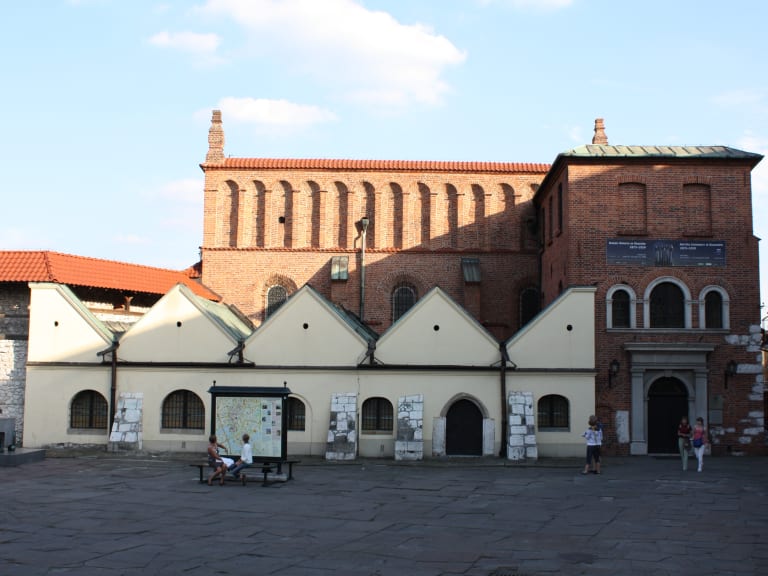
After lunch you have to walk for another 10 minutes to reach the next point of the tour: Kazimierz, the old Jewish quarter of the city. If you want to get to know it in depth, I recommend booking a tour of the Jewish Quarter. This area underwent a revitalisation after the filming of Schindler's List and is full of synagogues and very interesting corners.
In my opinion, it is one of the most attractive parts of the city, both for its streets and buildings and for the atmosphere. You only have to read the article What to see and do in Kraków's Jewish Quarter to get an idea of what is possible during a trip to Kraków.
The most important street in Kazimierz is called Szeroka. Here you will find several synagogues, Jewish bookshops and restaurants serving kosher food. There is also the Martyrdom Monument, which pays tribute to the 65,000 inhabitants of the neighbourhood who were murdered by the Nazis. As you won't have time to visit all the synagogues, I recommend two:
- Old Synagogue: Although the current synagogue dates from the 16th century, it is known that there was another synagogue on the same site a century earlier. Built in Renaissance style, it now houses a museum that explains how the Jewish community lived.
- Remuh Synagogue: this is the onlysynagogue in the entire Jewish quarter that continues to offer worship. It dates back to the 16th century and hides a cemetery at the back. There is an entrance fee, but it is an essential visit.
Practical information
- Opening hours: these synagogues (and the rest of the synagogues in Kazimierz) open at 9 am and close at 4 pm. In summer the closing time is delayed until 6 pm. Closed on Saturdays and public holidays.
- Entrance fee: the entrance fee is around 10 PLN (about 2.5 €). Some groups can buy a reduced ticket.
Relax with a drink at 2 Okna Cafe

A nice walk through the streets of the quarter and a visit to the synagogues is worth a reward. One of my favourite places to do this in Kazimierz is 2 Okna Cafe, located on Józefa Street.
The cafe, which also serves sweets, has a couple of tables outside. However, if the weather is nice, I recommend you to go into the inner courtyard.
In addition to coffee and tea, from the end of September onwards, the café offers a wonderful mulled wine. If you are feeling a little more daring, you can also try the hot beer or even the hot cider or vodka with spices.
A film set: the staircase from Schindler's List

An interesting place related to Oskar Schindler. In this case with the film, it is the stairs in an inner courtyard between Jozefa and Meiselas Streets. If you have seen the film, you will recognise the scene of one of its most dramatic scenes, the one that depicts the eviction of the ghetto by Nazi troops.
And if you want to learn more about the figure of Oskar Schindler, be sure to book a tour of the Schindler factory where you will learn more about this businessman who saved more than a thousand Jews during the Nazi occupation.
Plac Nowy, an atmospheric square to dine at
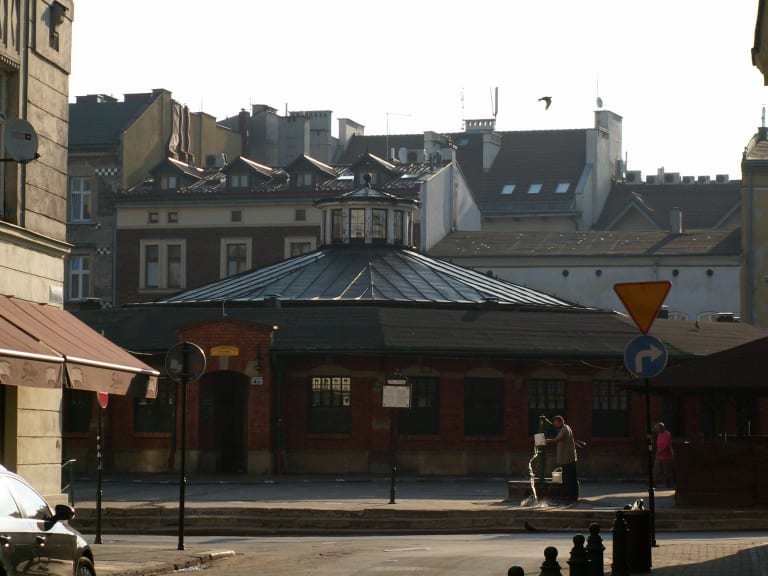
As you can see, there are plenty of things to see and do in Krakow. On your day trip, not only will you have to do without visiting the Wieliczka Salt Mines or booking one of the excursions to the Auschwitz concentration camp, but you won't be able to see some very worthwhile sights in the city itself. But you cannot miss Plac Nowy (New Square), also known by the nickname of Jews' Square.
In its centre is a circular building (the Okraglak) which was built in 1900 to serve as a poultry butcher's shop. Today, numerous stalls have been set up, both in the building and in various parts of the square. They sell a variety of food, from grilled meat to sausages and Poland's most popular fast food dish, the zapiekanka.
The square fills up with young people looking for a bite to eat, so much so that it is difficult to sit down on one of the few chairs in the square. However, you can also order your own food and look for a free bench. If you're in the mood, the streets around the square are full of cafés and pubs. The city's student atmosphere can be felt in these places, whose presence has given the neighbourhood a festive and bohemian atmosphere.
How to get from the airport to the city so as not to waste time
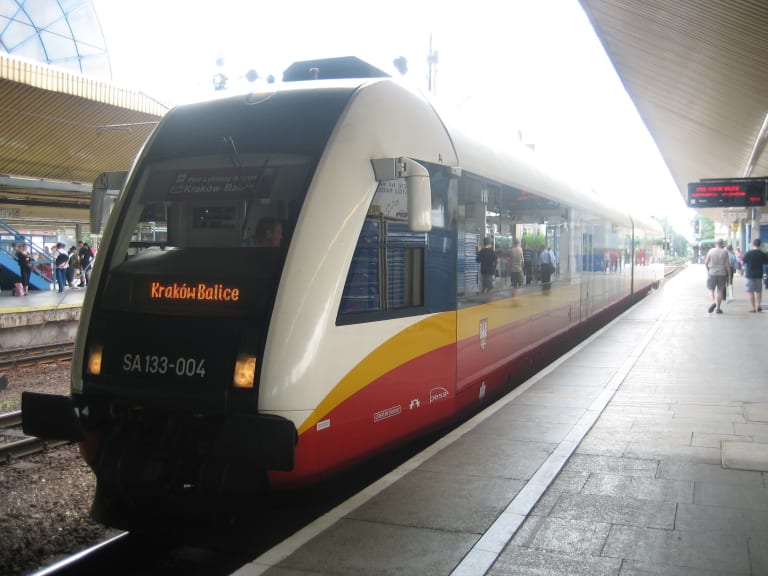
The fastest way to get from the airport to Krakow city centre is to hire a private transfer. Depending on traffic, it will only take about 25 minutes.
If you prefer public transport, you don't have to worry too much about how long it will take you to get to the city. There are several bus lines (208, 252 and 902) with a high frequency of departures that will get you to the city centre in about 45 minutes.
Finally, the fastest means of transport is the train. A train leaves the airport approximately every 30 minutes and arrives in the city in just 18 minutes. The stop in Kraków is at the central station**(Kraków Główny**), just a few minutes from the entrance to the historic centre.
Where to change euros to zlotys?
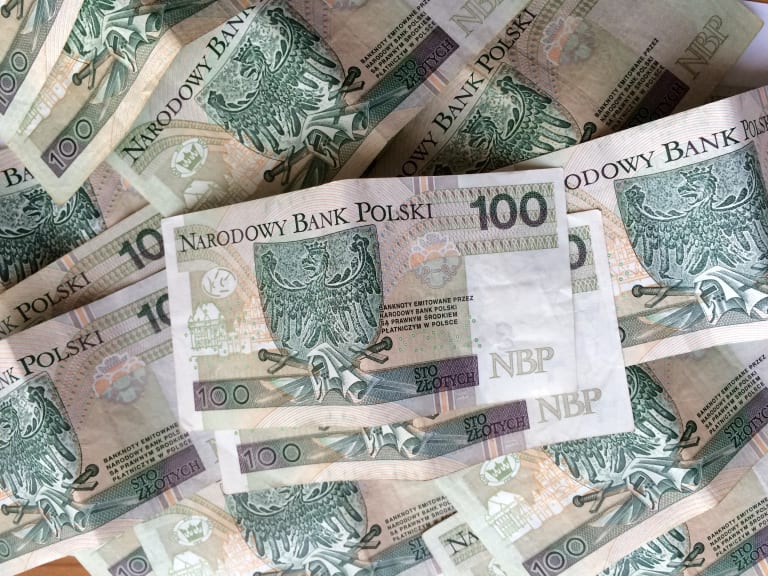
A good place to exchange money is the large shopping centre next to the central railway station. On the first floor there are a couple of exchange offices with a good rate.
In the city centre you will also find more exchange offices, with a much better rate than the one you can find at the airport. One of the best tips for visiting Krakow is to never change money on arrival, but to compare two or three to get an idea of the most favourable exchange rate.
You will also be able to pay by card in many shops and restaurants, especially if they are in the more touristy areas. If you prefer to withdraw money from a cash machine, I recommend that you check the possible fees charged by your bank for withdrawing cash abroad.




